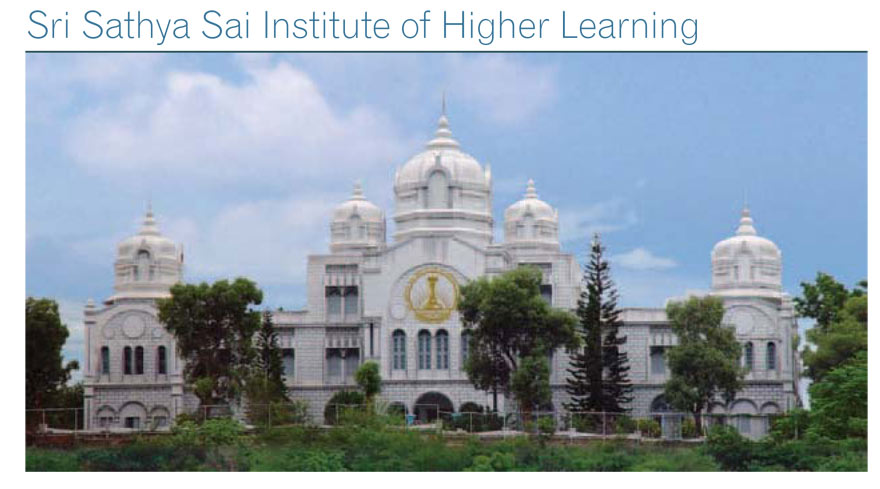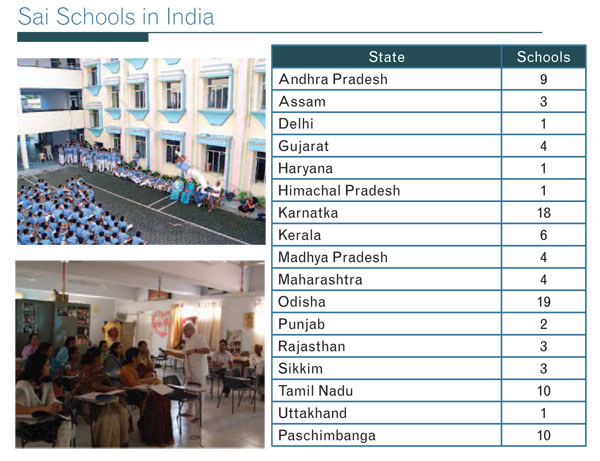|
|
| 'Like' us on Facebook | Follow us: |
Posted on: Mar 13, 2013
A Radio Sai Snapshot of the Sri Sathya Sai Central Trust
- Annual Report 2011 - 2012
a conversation with Prof. Anantharaman, Media Coordinator SSSCT
Part 03
The Lamp of Learning Continues to Shine Lustrously
Then, we talk about Educare. Previously, whenever we talked about Educare, we only talked about our University here which has integral education as its motive.
 |
KSM: Across its four campuses.
 |
 |
 |
 |
 |
 |
 |
 |
 |
| An info-graphic describing student-teacher ratio, research funding and student performance of SSSIHL | |||||||
Prof. AR: Across its four campuses. The fourth campus is operational since last year.
KSM: At Muddenahalli.
 |
Prof. AR: But there is more in the sense that we have a Secondary School (Sri Sathya Sai Higher Secondary School) which provides a lot of inputs of people into these universities. There is the Sathya Sai Vidya Vahini project which makes our value education available to school boards across the country. They have already gone and presented this to several school boards – 14 school boards of standard 6; almost 45 school boards have been given the first set of lessons. We've given a report about the Vidya Vahini team. And then, there are Sai schools in India.
 |
 |
 |
 |
 |
 |
 |
 |
KSM: I believe, 99 of them.
Prof. AR: Which we operate through several different Trusts. Last year, we integrated all of them into a single educational standard. These 99 schools are now being managed by our All-India Sai Organisation and they exist in every state. From Andhra Pradesh to Paschimbanga.
KSM: To Uttarakhand, Sikkim, Rajasthan, Odisha. So many places. Himachal Pradesh, Haryana, Gujarat, Karnataka, Kerala.
 |
Prof. AR: Exactly. So when we talk about Sai Education, it is not just the University alone, not the Primary School alone, but it exists all over. And more schools are springing up. These are the officially recorded ones; there are also other schools which are following the pattern and doing this.
KSM: I guess the time has come when people are recognising the value of character-based education – the model that Swami gave decades ago but never made a big deal about. Suddenly, He was busy sowing the seeds quietly and now, there is a harvest that's happening.
Prof. AR: He quietly introduced and then went on to the next thing. It's just blowing up. It's growing into a tree and becoming a forest today.
KSM: Yes. And it's yielding beautiful flowers and fruits.
Prof. AR: Last year, we introduced a whole column about the Annual Sports and Cultural Meet; we spent 10 pages talking about it mainly because it is a fiesta where all the bright young minds from all our campuses join together. In the past, they did all this in order to give joy to Swami. Last year in the absence of the physical form of Swami, we found their desire to give joy was probably even greater. They had newer events which completely talked about their dedication and teamwork and whatever they are capable of. It is a big building block as far as our youth in Sai movement is concerned.
KSM: Yeah! Creativity, leadership, skills or concentration ... everything.
Prof. AR: Absolutely! You find all kinds of creative ideas here. So, it's not just an Annual Sports and Cultural Meet; it's almost like a fiesta of creativity and innovation.
KSM: Indeed it is!
 |
 |
 |
 |
 |
 |
 |
 |
Prof. AR: That's why we gave a complete written page.
KSM: And there's a section on the Grama Seva project which is very popular amongst the students.
Prof. AR: Swami introduced this Grama Seva project several years ago in order to achieve 3 objectives. Number 1: He wanted to expose students and sensitise them to rural living. Secondly, He wanted to send a message to the people in rural area that there is a God who cares for them. Thirdly, He wanted to teach the students the basic principles of project management. He achieved all these 3, the strategist that He is; He achieved all these 3 objectives with a single project which is Grama Seva.
Grama Seva continued last year at exactly the same kind of an intensity and level as the Grama Sevas earlier. And we have given statistics of how many people were served, how many villages were served in this report: 153 villages spread across the 3 mandals of Puttaparthi. Again, when Swami did this, His intention was not to solve the problems of rural India. His intention basically was to establish a pattern and a model which students all over the country and all over the world can follow. While taking advantage of this to develop and provide integral education, value education to our own students, this also is a model for every University and every educational institution to follow.
 |
 |
 |
 |
 |
 |
 |
 |
KSM: And this, apart from being a case study, is such a learning ground for those who graduate from this University because our alumni are continuing this tradition wherever they are going.
Prof. AR: Absolutely! Not only our alumni, but also people in our All-India Seva Organisation. There are also hundreds of these unreported Grama Seva projects happening all along; some of them are being reported. But very soon, I get a feeling, we will probably not be able to report anything, because it will be so vast.
KSM: So vast, yes. All these years, we didn't talk about it. All of a sudden, now that we are collating this information, we are feeling so overwhelmed.
Prof. AR: Exactly! It was an absolutely fascinating experience. When we were trying to present this kind of a report, the whole vistas got revealed to us. None of us were aware of them. Or maybe we were aware, but we were not conscious of it all the time. But when we put them all together and see it all in one place, the first thought that comes in our mind is ‘Wow!’
KSM: Yes, indeed! So vast! It's all a one-person miracle. And Swami said if we believe that we are also God, each of us can bring about a similar miracle. Imagine!
Prof. AR: One person who was 5 foot 4 inches tall and weighed 115 pounds.
KSM: And who had no formal education and no seed capital to begin with.
Prof. AR: Dropped out of school. Yeah, exactly. It's amazing. It's so true it's completely unbelievable.
KSM: Yeah, because they say ‘The simplicity of truth renders it incredulous at times.’
Prof. AR: Then we talk about Sociocare where we have tried to give an organisational structure.







